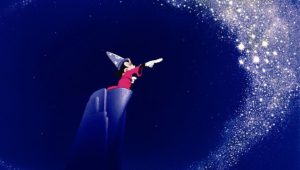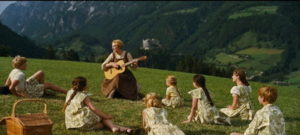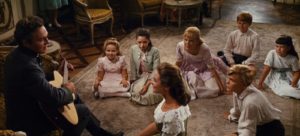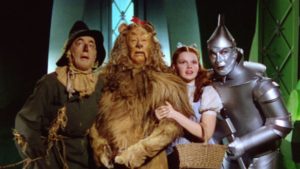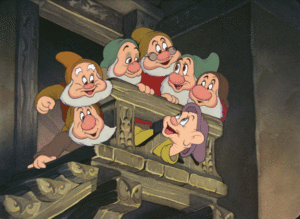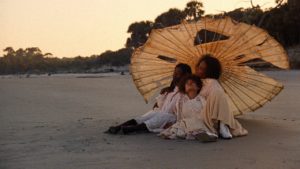
The first feature-length film in theatrical distribution directed and produced by an African American woman, Daughters of the Dust, resounds with rich portrayals of character, location, and cultural legacy. Director Julie Dash embraces moments of cultural history from an Afrodiasporic-feminist modality by centering the dynamics of a Black family within the remote Sea Islands along the coast of Georgia. The history of the slave trade involving these Sea Islands intersects with Dash’s concern for African American journeys toward origins. This intersection provides the setting for both a personal and a metaphoric guide to rendering and reading African American women’s lives.
The film opens with fragmented images of blue-stained hands, a boat landing, and a fully dressed woman rising out of the water. The camera then concentrates lingering, medium shots on three different women. Yellow Mary and her companion Trula travel in a boat that stops to pick up Viola. Trula and Viola travel back to the Sea Islands in order to witness the passage of the family’s migration North as well as their great-grandmother, Nana Peasant. One of the profound narrative elements of the film is centering of women’s perspectives. The film is very much functioned through the complex relationships between female and female. There is no focus on women’s heterosexual patriarchal relationships with men, for male characters are few and insignificant. Not only is it also just a female iconography but arguably a feminist iconography; a telling of this particular African American history and the history of slavery and its aftermath. It focuses on a group; within that wide already marginalized groups, we get to see this subgroup of the Atlantic side.
The film also plays with diasporic temporality. The film does not have a linear, straight plot line, which was a very different narrative style that was in opposition of the traditional Hollywood blockbuster storytelling. Dash wanted the audience to experience the film through the various connections between generations. The film is not plot-driven and is dependent on the relationships and dialogue between the family members. There are three narrators: unborn child (of Eula and Eli), matriarch Nana, union of what represents all of black women. We can see it as a visual poem – a focus on women and their bodies that doesn’t objectify or sexualize them. The broader theme of the film is thereby amplified by the interactions and visual images of and between the females of the film.
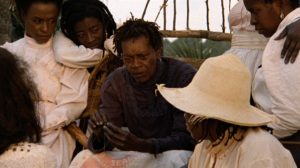
A critical scene that demonstrates the closeness of the relationships is the family gathered around on the beach to celebrate and commemorate the elder family members and the crossing of their family onto the mainland. The scene starts with an extreme long shot of two people riding across the beach on a bicycle who start in frame and then go out. There is then a cut of a closeup shot of the elder in the family, Nana Peazant, speaking about the importance of their gathering. The camera is placed specifically that characters are blocked in such a way that they overlap, in a sense showcasing that no one person is ever by themselves. Thus, no character is ever in a single shot alone. There is always at least one or more other characters within the same shot. For instance when a shot of Nana speaking to the family is shown, the mother of another family member is shown behind her, as if to comment on the family’s supportiveness. Most of the characters lean on eachother and sit very closely which further reveals a since of protection and security amongst them that they value.
In addition, the costumes in this scene create an important aesthetic thematically. During the commemoration, there is a tight shot of half of the family sitting together looking up at the figures standing. It seems that the shot was put together in such a way that near the foreground of the frame from the center to the right, all of the characters are dressed in white and cream colored clothing. They also happen to be the younger members of the family. Whereas in the middleground and background towards the left, characters placed wear navy blue and black colored clothing. These are the older members of the family who take on leadership roles. This is important because the difference in costume immediately signifies a difference in the characters position or role within the family. It also indicates the severity of the elders’ past revolving around slavery and the history living on Ibo Landing, significant site for African American history and part of an importance slave resistance in 1803.
The non-linear centering of African American female relationships, the stylistic use of blocking, and costumes employed throughout the film suggest a running theme throughout that calls attention to the importance of unity and security amongst a Black family, as in efforts to remember to pay homage to those who have paved the way for the younger generations.
A worthy note made by classmate, Kimberly, was the relative comparison of this film to the movie Pick Up on South Street. It was mentioned that the movie was released during the Cold War and contained prominent messages that portrayed communists as the enemy. She also mentioned how the communist characters in the movie were all deemed unlikeable and shady. Just from the characters alone, we as viewers can understand what themes and narratives the director of any film intended. Just as the communists were depicted as unlikeable, Dash portrayed all of the black women beautiful, complex, and un-sexualized. Highlighting a crucial and often hidden part of history. Drawing from another classmate’s film analysis, they had explained The Sixth Sense as a great film because “the way the director constructs the film to create tone keeps the audience on edge the whole time and then the ending shocks the audience and keeps them engaged seeking an explanation for the ending” (Finn-Mccue). Though the ending is no shock in Daughters of the Dust, there are deep messages that keep audiences intrigued to discuss and question what the ending – Yellow Mary staying on Ibo Landing – really means.
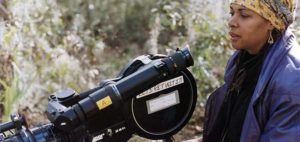
Director Julie Dash on production of Daughters of the Dust
Daughters of the Dust, without a doubt, should be included within the top 100 list because of the groundbreaking historical factors in being the first feature length film directed by an African American woman and therefore distributing a story and perspective that was ignored for generations. It stands as a classic not only within the independent film industry, but of all cinema for its beautiful portrayals of female relationships, fearless themes and cinematography, and the cultural meaning for so many people of color around the world. It is incredibly important to analyze films critically because whether we want to admit it or not, they lead us as a culture. We invest so much time, money, and efforts in celebrating this industry. It is extremely personal when you bring into context of how we, as a society, plan dates or events around going to the movie theater or having movie nights in our homes. It is especially important in this newer generation, considering how we have such easy access to online media sites such as Netflix. We are bombarded with so many narratives and characters that we become desensitized to it all. However, those images and themes stay with us. But only the movies that have the big bucks and people who allow these films to be distributed are consumed by the mass. It is crucial that we participate in researching the development, production, politics, social, and historical factors that go into creating a movie.
Sources:

